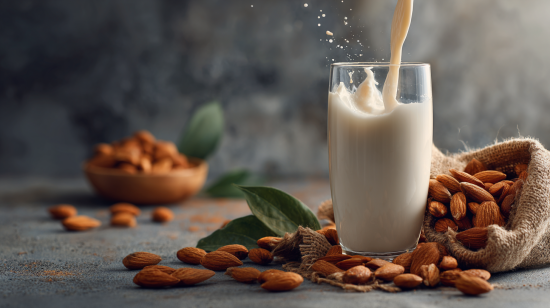
bettergoods Plant-Based Unsweetened Original Almond milk, Half Gallon
- bettergoods Plant-Based Unsweetened Original Almond milk, Half Gallon
- Smooth and delicious
- Perfect for savoring your morning coffee, enjoying a relaxing afternoon tea, or whipping up a culinary masterpiece
- Rich in calcium
- A good source of vitamins D and A
- Plant-based recipe
- 8 servings per container
$2.63
Discovering Dairy-Free Delight That Actually Tastes Good
My journey into the world of plant-based milk alternatives began not with a cheerful skip but with a reluctant trudge. After discovering my lactose intolerance three years ago, I found myself standing in the supermarket aisle, glumly eyeing rows of non-dairy options that promised everything but delivered disappointment in a carton. Watery textures, strange aftertastes, and ingredient lists that read like chemistry experiments—I tried them all.
That is, until I discovered Bettergoods Plant-Based Almond Milk—a game-changer that transformed my morning coffee ritual from a compromise to a celebration. Today, I’m sharing everything I’ve learned about this remarkable product, from what makes it special to where you can find it, and why it might just deserve a place in your refrigerator too.
What Exactly Is Bettergoods Plant-Based Almond Milk?
Let’s start with the basics. Bettergoods Plant-Based Almond Milk is exactly what it sounds like—a dairy alternative made primarily from almonds. But unlike many competitors that seem to contain more water than actual nuts, Bettergoods takes pride in their higher almond content, which explains that luxurious mouthfeel that had me doing a double-take the first time I tried it.
The first thing that struck me about Bettergoods was its color—a rich, creamy off-white that looks substantial in the glass, not the translucent watery appearance of some competitors. The consistency is what I’d describe as “Goldilocks perfect”—not too thick to be cloying, not too thin to disappoint. It pours with a silky elegance that suggests quality before you even taste it.
But what truly sets Bettergoods apart is their commitment to simplicity. While many plant-based milks compensate for flavor with lengthy ingredient lists, Bettergoods keeps things refreshingly straightforward. When I flipped over my first carton to scan the ingredients, I was pleasantly surprised by how few there were—and how many I could actually pronounce without a biochemistry degree.
The Ingredient Story: What’s Actually In That Carton?
Transparency matters to me, and I appreciate that Bettergoods feels the same way. Their classic unsweetened almond milk contains filtered water, organic almonds, a touch of sea salt, and minimal stabilizers to ensure consistency. No artificial flavors, no questionable preservatives, and absolutely no sneaky additives masquerading under scientific-sounding names.
What you won’t find is equally important: Bettergoods Almond Milk is completely free from carrageenan, a controversial thickener that some studies suggest could cause digestive issues. As someone with a sensitive stomach, this omission was a major selling point for me.
The almonds themselves are thoughtfully sourced. Bettergoods uses organic, non-GMO almonds grown using sustainable farming practices. This attention to ingredient quality translates directly to flavor—there’s a pure, clean taste that lets the natural nuttiness of the almonds shine through.
For those concerned about nutrition, Bettergoods doesn’t skimp on fortification. Their almond milk contains added calcium (providing about 30% of your daily value per serving), vitamin D, and vitamin E. This makes it nutritionally comparable to dairy milk in certain key areas, which helped ease my transition away from cow’s milk.
A Tour of Flavors: Beyond the Basic Carton
When I first discovered Bettergoods, they offered just their signature unsweetened variety. Now, their lineup has expanded to include several appealing options that keep me from ever getting bored:
- Unsweetened Original: My everyday go-to. Clean, pure almond flavor with zero sugar and minimal calories. Perfect for both sweet and savory applications.
- Original: Lightly sweetened with organic cane sugar for those who prefer a touch of sweetness without going overboard.
- Vanilla: My weekend treat. Infused with real vanilla bean (not artificial flavoring), this variety makes my morning oatmeal feel positively decadent.
- Chocolate: The newest addition to their lineup and an instant hit in my household. Rich, cocoa-forward, and sweetened just enough to feel like a treat without the sugar overload of many chocolate milks.
- Barista Blend: A specialized formula with a slightly higher fat content designed specifically for coffee applications. It froths beautifully for lattes and doesn’t separate when heated—a revelation for someone who had given up on proper cappuccinos.
Each variety maintains Bettergoods’ commitment to clean ingredients while offering enough diversity to keep your taste buds engaged. I keep at least two varieties in my refrigerator at all times—usually the Unsweetened Original for cooking and the Vanilla for direct drinking and breakfast applications.
Nutritional Breakdown: What’s In Your Glass?
As someone who tracks my macros, I appreciate how Bettergoods Almond Milk fits into my nutritional goals. The unsweetened variety, which is my personal staple, contains:
- Calories: 30-35 per 8-ounce serving
- Fat: 2.5g (primarily healthy monounsaturated fats from the almonds)
- Protein: 1g (lower than dairy milk, which is worth noting if you’re counting protein)
- Carbohydrates: 1g (with 0g sugar in the unsweetened varieties)
- Calcium: 30% DV
- Vitamin E: 50% DV
- Vitamin D: 25% DV
The sweetened varieties contain between 5-7g of added sugar per serving—significantly less than many competitors who sometimes sneak in up to 12g per cup. The chocolate variety has 9g of sugar, which is practically austere compared to conventional chocolate milk’s 24g+ per serving.
I appreciate that Bettergoods doesn’t try to compete with dairy milk on protein content by adding random protein isolates. Instead, they’re transparent about almond milk’s natural limitations while maximizing its natural benefits—like being naturally lower in calories and containing healthy fats.
Where Can You Find This Liquid Gold?
When I first fell in love with Bettergoods Almond Milk, finding it required some detective work. Today, its availability has expanded considerably, though it still maintains its premium positioning rather than becoming ubiquitous in every corner store.
You can reliably find Bettergoods at:
- Natural and organic grocery stores: Whole Foods, Sprouts, and Natural Grocers carry the full line in most locations.
- Conventional supermarkets: Target, Kroger family stores, and some Walmart locations now stock at least the original variety.
- Online retailers: Amazon Fresh, Thrive Market, and the official Bettergoods website all offer direct shipping, sometimes with subscription options that save you between 10-15%.
- Specialty coffee shops: Many independent cafés now offer Bettergoods Barista Blend as their plant-based milk option.
I’ve found that availability can vary significantly by region. In coastal urban areas, you’ll find the complete product line with ease. In more rural or midwestern locations, you might need to seek out specialty stores or order online.
Price-wise, Bettergoods positions itself as a premium option. Expect to pay between $4.99-5.99 for a 32-ounce carton, depending on the variety and location. The Barista Blend typically commands about a dollar more. While this is certainly pricier than conventional almond milk brands or store generics, I’ve found the quality difference justifies the additional cost.
Savvy shoppers should look out for occasional promotions. I’ve spotted “buy one, get one 50% off” deals at Whole Foods several times a year, and the company often offers introductory discounts through their newsletter for first-time online purchasers. Buying in bulk online can also reduce the per-unit cost significantly.
The Sustainability Question: How Green Is Your Milk?
Let’s address the elephant—or rather, the almond tree—in the room. Almond cultivation, particularly in California where most of the world’s almonds are grown, has faced criticism for its water usage. As someone who tries to make environmentally conscious choices, this initially gave me pause.
Bettergoods has approached this challenge head-on. Their almonds are sourced from farms employing micro-irrigation techniques that use up to 30% less water than conventional methods. Additionally, they partner with farms practicing regenerative agriculture, which helps build soil health and sequester carbon.
The packaging represents another area where Bettergoods demonstrates environmental commitment. Their cartons are made from FSC-certified paperboard and are 100% recyclable. In select markets, they’ve begun testing plant-based caps made from sugarcane rather than conventional plastic.
Bettergoods has committed to carbon-neutral operations by 2026, a goal they’re pursuing through a combination of emissions reductions and verified carbon offset projects. While no food product has zero environmental impact, it’s clear that Bettergoods takes their ecological responsibility seriously.
Compared to dairy milk, Bettergoods Almond Milk still represents a significant reduction in greenhouse gas emissions, land use, and overall environmental footprint—even accounting for almond cultivation’s water requirements.
In the Kitchen: Cooking and Baking with Bettergoods
One of my initial concerns when switching to plant-based milk was how it would perform in my favorite recipes. After extensive experimentation, I can confidently report that Bettergoods performs exceptionally well in culinary applications—with a few caveats.
For baking, the unsweetened original variety substitutes perfectly in most recipes. I’ve used it in everything from pancakes to muffins to birthday cakes with no detectable difference in texture or rise. The vanilla variety adds a lovely subtle flavor to sweet baked goods—try it in french toast for a game-changing breakfast experience.
When it comes to cooking, Bettergoods works beautifully in creamy soups, mashed potatoes, and pasta sauces. It doesn’t break or separate when gently heated, though it doesn’t thicken quite like dairy milk. For recipes that rely on milk proteins for thickening (like certain puddings), you might need to adjust your technique slightly.
Coffee applications deserve special mention. The Barista Blend is specifically formulated to work in hot beverages without separating or creating that unappealing “cloudy” effect that plagued early plant milks. It froths remarkably well, creating a microfoam that holds its structure long enough for latte art—something I never thought possible with almond milk.
One surprising success: homemade ice cream. Using Bettergoods Vanilla Almond Milk in my ice cream maker produced a surprisingly creamy frozen treat with a delicate almond undertone that complemented my usual vanilla bean flavor perfectly.
The one area where I’ve found Bettergoods doesn’t quite measure up to dairy is in creating rich custards. The lower protein content doesn’t provide the same structural support, though this can be overcome by adding a small amount of cornstarch or additional egg yolks to your recipe.
Storage Tips and Shelf Life: Making the Most of Your Purchase
Given the premium price point, maximizing the shelf life of your Bettergoods Almond Milk makes economic sense. Here’s what I’ve learned through (occasional) trial and error:
- Unopened shelf stability: Bettergoods shelf-stable varieties can be stored in your pantry for up to 9 months. The refrigerated versions need constant cooling and have a typical unopened shelf life of about 45-60 days.
- After opening: All varieties should be refrigerated after opening and consumed within 7-10 days. I’ve found the product maintains its quality well within this timeframe, with minimal separation or flavor degradation.
- Temperature sensitivity: Unlike dairy milk which can sometimes survive brief periods at room temperature, Bettergoods seems particularly sensitive to temperature fluctuations once opened. Leaving it out during a lengthy brunch can accelerate spoilage.
- Freezing potential: In a pinch, you can freeze Bettergoods Almond Milk, though the texture changes slightly upon thawing. I sometimes freeze small portions in ice cube trays for adding to smoothies.
One helpful quality indicator: Bettergoods tends to separate slightly when it’s approaching the end of its freshness. If you notice distinct layers after shaking, it’s best to use it for cooking rather than drinking directly.
How Does Bettergoods Compare to Competitors?
The alternative milk section has become increasingly crowded in recent years, so how does Bettergoods stack up against other options? After trying nearly every almond milk on the market (a side effect of my dairy-free journey), I can offer some comparative insights:
Bettergoods vs. Almond Breeze: Almond Breeze is more widely available and typically cheaper by $1-2 per carton. However, Bettergoods offers a noticeably creamier texture, fewer additives, and a more pronounced almond flavor. Almond Breeze contains more stabilizers and tends to have a thinner consistency.
Bettergoods vs. Califia Farms: The closest competitor in terms of quality positioning. Both offer excellent texture and clean ingredient lists. Califia’s distinctive bottle shape might appeal to some, while Bettergoods edges ahead slightly in creaminess and has better coffee performance in my experience.
Bettergoods vs. Silk: Silk’s almond milk is widely available but contains more additives than Bettergoods. The flavor profile of Silk tends toward sweeter, even in their unsweetened varieties, while Bettergoods maintains a more authentic almond taste.
Bettergoods vs. Store Brands: The price differential is most pronounced here, with store brands often priced at half the cost of Bettergoods. However, the quality difference is equally stark—store brands typically have lower almond content, more fillers, and a waterier consistency.
For those wondering about other plant-based alternatives beyond almond, it’s worth noting that Bettergoods has recently launched oat and cashew varieties as well. Their oat milk in particular has become a fast favorite for its exceptional creaminess and neutral flavor that works wonderfully in savory applications.
The Community Response: Reviews and Customer Experiences
I’m clearly enthusiastic about Bettergoods, but I’m not alone in my appreciation. Online reviews consistently award their products 4.5-5 stars across various platforms. The most commonly praised attributes are texture, flavor authenticity, and clean ingredients.
Professional baristas have become particularly vocal advocates for the Barista Blend. Several award-winning coffee professionals have publicly endorsed it as their preferred plant-based option for competition work—high praise from an industry that scrutinizes every aspect of their craft.
Nutritionists and dietitians frequently recommend Bettergoods for its lower sugar content and absence of controversial additives. Several prominent health and wellness influencers have featured the brand in their content, further cementing its reputation as a premium option for health-conscious consumers.
That said, no product earns universal acclaim. The most common criticisms center around price point and occasional availability issues. Some consumers have noted batch-to-batch variations in consistency, though the company has worked to address this through improved quality control measures.
Parents have mixed reviews about children’s acceptance of the product. While many kids enjoy the sweetened and chocolate varieties, the unsweetened version can be an acquired taste for younger palates accustomed to dairy milk’s natural sweetness.
Is Bettergoods Right for You? Making the Decision
After diving deep into all things Bettergoods Almond Milk, you might be wondering if it deserves a place in your refrigerator. Here’s my take on who might benefit most from this product:
Bettergoods might be perfect for you if:
- You’re seeking a dairy alternative with exceptional taste and texture
- Clean ingredients and minimal additives are important to your food choices
- You’re willing to pay a premium for quality and sustainability
- You use plant milk in coffee and are frustrated by curdling or poor frothing
- You have dietary restrictions requiring dairy-free, gluten-free options
You might want to look elsewhere if:
- Budget is your primary consideration when shopping
- You’re seeking a plant milk with protein content comparable to dairy
- You don’t consume enough plant milk to justify the premium pricing
- You need extremely long shelf life for infrequent use
For those curious but hesitant about the price point, I’d recommend starting with a single carton of their Unsweetened Original. This versatile option will give you the clearest sense of the product’s quality and can be used in virtually any application from drinking to cooking.
My Personal Bettergoods Journey: From Skeptic to Advocate
When I first spotted Bettergoods at my local Whole Foods, I’ll admit I experienced sticker shock. Six dollars for almond milk seemed excessive, especially when the store brand was sitting right next to it at half the price. But after another disappointing experience with a cheaper brand that separated unappealingly in my morning coffee, I decided to give it a try.
That first taste was revelatory. The creamy texture and clean, authentic flavor immediately distinguished it from every other almond milk I’d tried. When it performed flawlessly in my coffee—no separating, no weird aftertaste—I was sold.
What began as an occasional splurge has become a pantry staple. I’ve found ways to make it work within my budget by watching for sales, occasionally ordering in bulk online, and using it strategically (saving the premium Barista Blend for my morning coffee ritual while using the regular unsweetened for cooking).
Beyond the product itself, I’ve come to appreciate the company’s transparency and values. When I reached out with questions about their almond sourcing, I received a detailed, thoughtful response rather than corporate boilerplate. Their visible commitment to sustainability aligns with my own values, making the premium price point feel like an investment in better practices.
Finding a plant-based milk that genuinely enhances rather than merely accommodates my dairy-free lifestyle has been truly transformative. What started as a reluctant dietary change has become a preference—I now actively enjoy my Bettergoods Almond Milk rather than viewing it as a compromise.
Final Thoughts: Is Bettergoods Worth the Hype?
After months of regular use and testing Bettergoods Almond Milk in countless applications, my verdict is clear: this is a premium product that delivers on its promises. The exceptional texture, clean ingredient list, and versatile performance justify the higher price point for those who use plant-based milk regularly and care about quality.
Is it perfect? No product is. The premium pricing puts it out of reach for some consumers, and those seeking high protein content will need to look elsewhere or supplement accordingly. Occasional availability challenges can be frustrating, though these have improved as the brand has expanded.
But for someone like me—committed to a dairy-free lifestyle but unwilling to compromise on taste, texture, and ingredient quality—Bettergoods has been nothing short of revolutionary. It’s transformed plant-based milk from a functional necessity to a genuine pleasure.
If you’ve been disappointed by other almond milks or are just beginning your dairy-free journey, I encourage you to give Bettergoods a try. Your morning coffee—and everything else you might use it for—will thank you.
And if you do try it, I’d love to hear your thoughts. Are you as impressed as I am, or do you have another favorite? The world of plant-based alternatives is constantly evolving, and sharing our experiences helps all of us make better choices for our health, our taste buds, and our planet.
Until next time, happy (plant-based) sipping!







